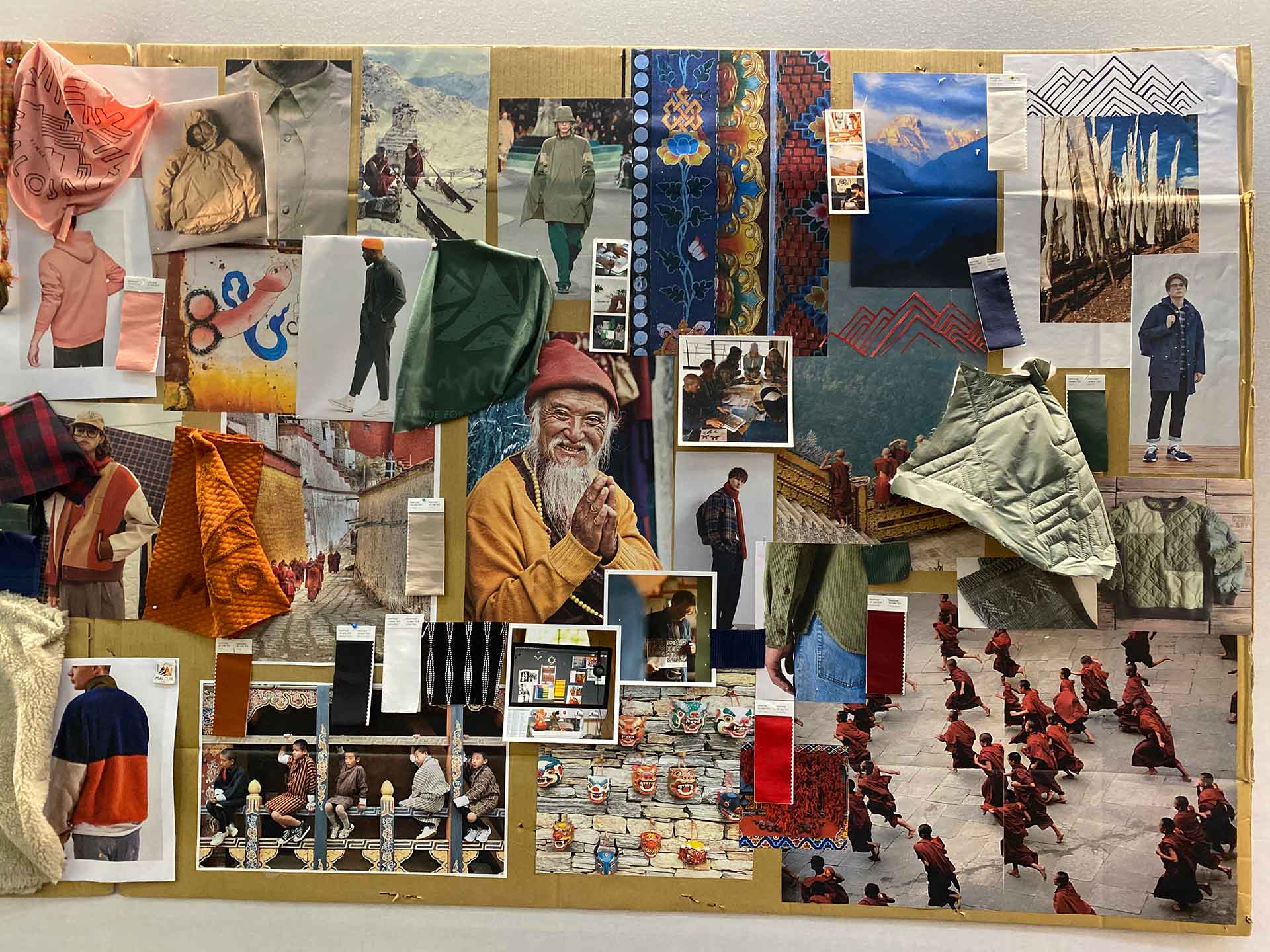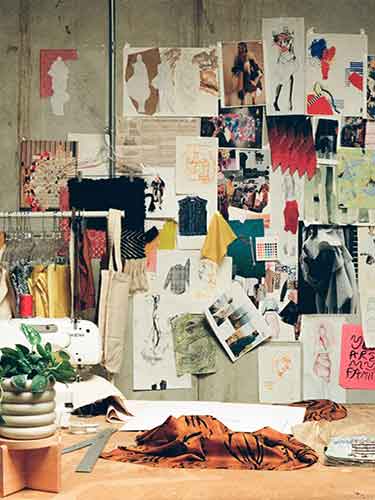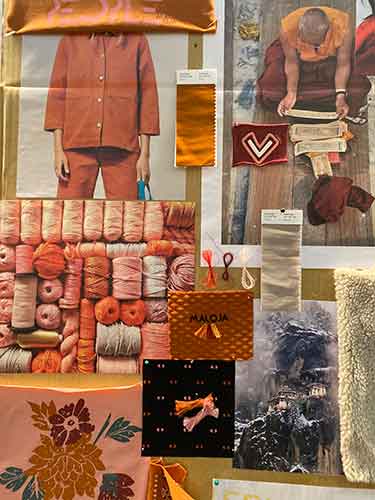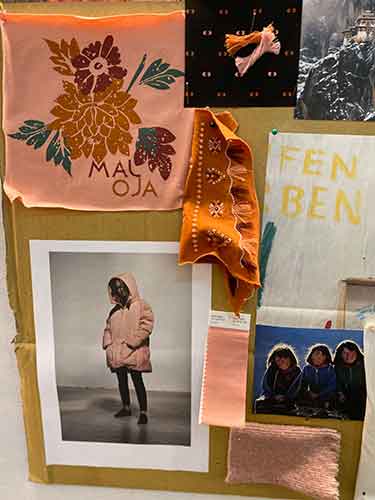
HOW TO CREATE A FASHION MOOD BOARD
Fashion mood board, visual board, inspiration board, storyboard… whatever you choose to call them is up to you. No matter the name, they are a fantastic way to set the visual direction for an apparel brand project.
Traditionally fashion mood boards were made in physical format, with magazine tear-outs, pictures, and swatches pinned on a foam board, but today you can create them to suit your working style and brand needs.
In this post, you will get actionable mood board tips so you can go and create yours asap. But first, let’s start from the beginning.
A fashion mood board is a collage. A visual summary of inspirational images, objects, material swatches, trims, or product examples that explain the concept and feeling of your brand, collection, or customer. It is basically a brain dump of whatever you are inspired by. The inspiration can be a theme, a place, a color scheme, a material story, or entirely functional, based on the activity of your customer.
It is a design tool that will help you remain focused and consistent as your clothing line develops.
Fashion mood boards are a perfect communication tool when explaining your vision to others. It can be your team or your product developers, supplier, manufacturers, retailers, etc.
You can either do it on the computer or on a big hardboard or foam board. Personally, I love to touch things and feel the textures, so a physical board or wall is my thing. Try both till you find your favorite way of working.
Fashion mood boards can also be used in many more areas than just the collection and product design.
You can use mood boards to brief a branding designer for creating your brand designs.
You can use a fashion mood board to brief a web designer on how to create your website.
You can use a fashion mood board for pretty much any other type of design project.
Why do you need a fashion mood board for your apparel brand?
The fashion mood board helps you find your inspiration. It will help you refine your ideas. You might think that you have a strong idea in your head, but by putting it in front of you, a mood board will give you the clarity you need before you start designing and getting all the materials.
It will also make you stay consistent and focused on your brand values. You will have the inspiration in front of you, and you will be reminded of where you are going. Before designing your garments, the images and objects on the board will help you steer in the right direction.
The fashion mood board also helps you communicate your ideas and give you the same visual reference with your team.
How to make a fashion mood board
The fashion industry is enormous, with hundreds of thousands of brands. As a creative, you want to make collections and products that are unique, that are authentic and that speak YOUR voice as a designer and brand founder.
The mood board phase is the start of something unique, the start of something no one else has. Because the choice of pictures, swatches, things you put on the board are entirely uniqe to YOU. This is where you create your own universe, with your values, your taste, with your individual vision.
The fashion mood board phase starts with research. Go to galleries, museums, fabric fairs, and shops. Listen to music, watch movies, see what’s in style on the streets, look at architecture, design objects, industrial design, visit boutiques. Old photos, accessories, trims, basically any visual reference. Be open to what catches your interest and what you get ideas from.
Google search words and see where that takes you.
If you are a creative, we assume you have tons of notebooks with brilliant notes and sketches, and great ideas. Look through your scrapbooks if you have any. What’s in your notebooks and your scrapbooks is already curated. The chances are you might want to use those somehow. Now might be an excellent time for your next collection.
For more “live” inspiration, go on a trip, go to galleries, exhibitions, the library, or to a music festival. Buy fashion, design, and architecture magazines that catch your eye. Your board doesn’t necessarily have only to include garment pictures. It can be a modern architectural building, a beautiful sculpture, a vintage shoe, a breathtaking view, a specific film, a song, even a conversation.
Use a big foam board or a hardboard or even a wall. Select your pictures and items you want to put on the board or wall and pin them to the board. A good suggestion is to pin the items so you can remove or replace them if things change or if you just want to rearrange the board.
You can write down words that pop up in your head and put them on your board. For some people, words are more inspirational than images.
It is very easy to look at what other brands are doing and to pin pictures of referential garments. But please give yourself a challenge, and DON’T include competitors products on your board. You could have details and smaller parts of a garment picture for fit or detail referral, but going back to the word unique, create your own twists.
You can also pin material swatches and trims you like. You can make small mock-ups for exciting design solutions. Pin anything that will evoke some sort of feeling.
It could be a good idea to give your board a title, like a phrase or a name. Theme keywords and inspiration words. Combine two or several words, a phrase from a movie, a poem. Choose whatever textual form that inspires you.
This can be used later in all your marketing and sales material.
No matter how many pics and things you have on your board at the end, edit. The pics that don’t speak to you that much, or that are not precisely on “topic” should be taken off the board. Consistency is key. Too many different things can give a messy impression. With time you will learn how to curate.
Think about why you have chosen the pictures and maybe note it down. It will help you explain your ideas and what you are trying to achieve later when you talk to your team. What emotions are your pictures evoking? Pay extra attention to that.
To make sure you are consistent in your head and not only on your board, present the mood board to a team member or a friend. Is it clear? Do they get it? Do they feel the direction you are going in? Do they understand what’s important? If not, rework it to make it even more clear.
Saying things out loud will force you to think what makes sense and what doesn’t follow the red thread.
All items should complement each other and have a particular look that the brand is either looking for or is known for.
Look at it critically, take a step back, take a break, step away from it for a while to get a new perspective. Maybe pause for a day or two. When you return to it, see what sticks out, what is not clear, and what you should rework.
Not every picture or item on the mood board has to directly link to the design you are going to create later on in your collection. It can, but it doesn’t have to, it can just simply work as an inspiration.
One more crucial thing: Have fun! This part, before the product development phase, is essential and will dictate the tone of your collection. Give yourself a couple of days or even weeks, don’t stress or force it, and trust the process. Take a step back, look at it from afar, and open your brain up for the input flow that it will give you. Take notes and even sketch if you get immediate ideas.
When you are finished, make an edited digital version. It will serve as a fantastic communication tool. You can use it on social media, in your look books, you choose. The mood board is a living document and should be changed season to season because, like you, your brand will evolve.
You may even make different mood boards, the main one, smaller ones for prints for example, or for the marketing team, or for the photographer.



9 Moodboard tips
Now onto some tactics on how to create a mood board:
What is it that you want to achieve? Do you want a “literal” board with exact colors, materials, fonts, or product pictures, or do you want an inspirational, vibe setting mood board? You could also start with one, the vibe and mood-setting one, and finish with the actual final one where you have edited and OKed everything on it.
Before you start pinning and selecting pictures and things, think about the direction or theme of where you want this to go in. Do you want to go punk rock or free spirit? But what you shouldn’t do is be all over the place with your things on the board. Remember, there should be a red thread and consistency in everything. If you are designing seasonal collections, then the mood board should reflect the season you want to design for.
Add, for example, pics that set the tone for your inspiration. What is the place for your product? Is it the beach, or a city? Then continue to add pics related to this topic. You set the tone and vibe of where your products will be used and add pictures and references that inspire you all the way down to details like a button, for example. Remember that the images you add can also be consistent in color to take the inspiration to the next level, or add color swatches directly.
To indicate the importance of the pics you can work with size. The more essential pics can be bigger in size and the less important ones a bit smaller. Add colors, fonts, materials swatches to create a balance. It should feel comfortable to the eye and remember, we see things from top left, to the right, then down left towards right. Another way is to focus from the center of the board, outward. You can also group related pictures for a stronger impact.
Layer the images on top of each other, group them neatly, on colors, on a vibe, on personality.
The layout is completely individual. Some want a super neat board, some want a creative fashion mood board with pics stacked, materials swatches, even products. It all depends on you and how you want to use the board.
There is no right amount of time that someone should spend on creating the board. It all depends on how much information and material you have collected or created before making the board. It depends on how many notes you already have, how fast and decisive you are in the research phase, and if you are a person that knows exactly what they want.
Because the more time you spend here, on researching and creating an excellent fashion mood board, chances are, the smoother your project will run. Because the principal directions are set, the “hard” design and collection decisions are taken, you need to focus on the creating and following the mood board.
Mood boards are more visual, but this can be highlighted by notes and sounds, even smells.
Do put poems, or quotes on your board if you feel it helps you and strengthens your direction.
Do you have a particular song that you want to be connected to this project, then add it or play it. Do you have specific smells, add those too. Everything that increases your inspiration and takes you to that final “dream” helps.
You will know for sure what you like and what you don’t like. Notice what resonates with you, don’t force anything. If something is NOT speaking to you, then don’t put it on the board. Make two piles if you have to, one that is 100% and one with 80%. The 100% you put on the boards, edit and see what happens. When you are done, take a look at your 80% pile and see if something from there should fit in better. Curation and editing are key!
And what do you edit, well, everything that doesn’t fit in with your story or that’s odd or sticks out. A strange color or a detail that is completely isolated, for example.
When you think you are done, you are not really done. You might have worked a lot on it, and you might also get tired of seeing it, but sleeping on it one night will give you a new different perspective. You will probably change some things or not, but at least you will be more finished with one night’s sleep view.
And finally, enjoy, this is one of the best parts about having your own brand, the playing, the dreaming, the visualizing, and the conceptualizing.
One thing that should ALWAYS stay the same is your target customer or your muse. The person that you are designing and creating for. Your customer will remain the same, his/her values will stay the same, the beliefs will stay the same. It’s just the seasons that shift.
Physical or digital fashion mood boards?
Physical boards are easy to create, and they don’t require much space. If you do them on loose boards, you can easily move those around, take them with you to meetings, or store them away.
If you use a wall as your board, then, yes, that’s a bit more permanent solution, but this can be a good thing. When you see your fantastic fashion mood board every day, you will keep the inspiration going, and you will keep the motivation up. New ideas can take shape, and you can tweak the board as you work, take down pieces from the wall, go to your desk, work for a bit, repin them on the wall, etc.
From a bigger board or wall, you can always edit and create a smaller board. By taking the essence out, you could make it even more evident.
The advantage of digital boards is that they don’t need any physical space. You can’t lose them, you can’t mess them up, you cant spill coffee on them, they are on your computer. You can adjust the pictures you find online very easily in Photoshop, for example.
You can easily email them to your team or people you work with, and you can use them in all your media.
Whichever form you use depends on what you want to accomplish with the board. If it’s only for you, then it doesn’t matter, you do it the way it suits you. If you have a team and the boards need to be sent back and forward, then a digital form is better than physical.
It also depends if you only have pictures or color swatches on your board, then it doesn’t matter which format it is. If you want and need to have fabric swatches, trims, and accessories, textured physical products, you absolutely need to do it in physical form.
Personally, I don’t find digital mood boards as fun. I sit in front of the computer all day long. When the inspiration and creative time arrives, I want to fully immerse myself in it and get away from the computer. There’s something nice about cutting and pasting and playing around with pictures and swatches. We don’t work in analog ways today, most of what we do it on a computer. It can be a good thing. To creating something truly unique, you have to do things in other ways than what you are used to. It will most probably force you to think more outside of the box.
Remember that you can combine both to suit your needs. Material swatches can be scanned in, or you can take pictures of the swatches. You can tear out magazine pictures and add them to your board, just have fun with it and play around. There are no rules! Lean into your creativity and let it flow for a while.
You can create several mood boards: one main version for the collection theme, one for the prints, one for the fit and silhouette, one for graphical elements, one for trims, one for colors. You decide. The more boards you have, the easier it will be to do the actual design. Because you know what to focus on, all that is left is the actual incorporation of the board and implementation.
Note the explanation to all the things pinned on the board and keep track of what you want to say with each thing and why you chose it. Why is that thing important for the board?
By doing this, you will become very clear with your intentions, both for yourself and your team.
And clarity saves time! And time is money:)
There are a lot of great resources online to help you create your fashion mood board, physical or digital. We have put together a list with fantastic mood board apps, mood board generators, mood board tools, and mood board resources.
Great for inspiration pictures. The mother of all mood board sites.
Perfect for layouts and templates. You can use Canva for graphics, social media, and basically all your marketing material.
Online mood board generator. Stunning interface and very easy to use.
Userfriendly with drag and drop functions plus picture and color editing functions.
Online color generator
A notetaking app to keep track of ALL your notes and ideas. It’s fantastic!
Huge image databank
Online source of freely usable images.
Adobe Creative Suite with Photoshop, Illustrator, and InDesign. Programs you will use in your business from Product design to pictures and all your marketing material. A must for all apparel business entrepreneurs.
With your completed fashion mood boards, you know where you are going. You know what the collection direction is. With the final information in front of you, it’s easier to design. You can dig right in, start sketching and start with your material sourcing.
The entire team is on board with what theme they are working towards, and this makes it way easier to reach the end goal.
Now you also have material to brief your graphic designer or your marketing team.
When you have put so much research and time into the planning phase, you will save a lot of time in the implementation stage.
Enjoy, this is one of the best things about being an apparel designer and entrepreneur. You are the one putting out the vision and the direction.
This Course will guide you through our proven 6-step success blueprint, on how to go from just an idea, to learning exactly what it takes to launch your own profitable sustainable apparel brand.
Your data will be handled according to our privacy policy.